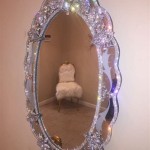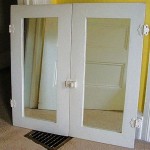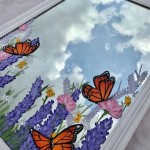Arts and Crafts Mirror: A Reflection of Design and Philosophy
The Arts and Crafts movement, flourishing between 1880 and 1920, significantly impacted decorative arts, including mirror design. Arts and Crafts mirrors stand as enduring testaments to the movement's core principles, emphasizing handcrafted quality, natural materials, and simple, functional beauty. These pieces, imbued with a distinct artistic character, went beyond mere utility, embodying a social and artistic philosophy that celebrated honest craftsmanship and rejected the mass-produced aesthetic of the Industrial Revolution.
Key Characteristics of Arts and Crafts Mirrors:
- Emphasis on Handcraftsmanship
- Use of Natural Materials
- Simple and Functional Design
The movement's rejection of industrial production methods meant that each Arts and Crafts mirror was a unique, handcrafted creation. Artisans poured their skill and attention into every detail, resulting in mirrors imbued with individual character and artistic expression. This focus on handcraftsmanship was not simply a stylistic choice; it reflected the movement's belief in the dignity of labor and the importance of connecting with the materials and processes of creation.
Materials Commonly Used:
- Oak
- Walnut
- Cherry
- Copper
- Brass
Natural materials were fundamental to the Arts and Crafts aesthetic. Oak, walnut, and cherry wood were frequently used for frames, chosen for their inherent beauty and durability. Metals such as copper and brass often provided decorative accents, hammered or etched with nature-inspired motifs. The use of these materials underscored the movement's connection to the natural world and its rejection of artificial or synthetic materials.
Common Decorative Motifs:
- Stylized floral patterns
- Geometric shapes
- Leaded glass accents
The designs of Arts and Crafts mirrors were characterized by simplicity and functionality. Ornamentation, while present, was always purposeful and restrained, serving to enhance the beauty of the natural materials rather than overshadowing them. Stylized floral patterns, geometric shapes, and occasionally leaded glass accents provided subtle decoration, reflecting the influence of nature and traditional craftsmanship.
Influence of Key Figures:
- William Morris
- Gustav Stickley
- Charles Robert Ashbee
Key figures within the Arts and Crafts movement significantly influenced mirror design. William Morris, considered the father of the movement, advocated for honest craftsmanship and traditional techniques. Gustav Stickley, known for his straightforward furniture designs, promoted the use of simple, sturdy forms and locally sourced materials. Charles Robert Ashbee, another prominent figure, emphasized the importance of handcrafted beauty and the social value of skilled labor. Their philosophies shaped the distinctive characteristics of Arts and Crafts mirrors and the broader movement.
Distinguishing Arts and Crafts Mirrors from Other Styles:
- Simpler designs than Victorian mirrors.
- Less ornate than Art Nouveau mirrors.
- Emphasis on rectilinear forms.
Distinguishing Arts and Crafts mirrors from other styles requires careful observation. While Victorian mirrors often feature elaborate curves and excessive ornamentation, Arts and Crafts designs are considerably simpler and more restrained. Compared to the flowing, asymmetrical lines often seen in Art Nouveau, Arts and Crafts mirrors tend toward rectilinear forms and geometric patterns. This emphasis on simplicity and functionality sets them apart, reflecting the movement's distinct philosophy.
Collecting and Caring for Arts and Crafts Mirrors:
- Examine the craftsmanship.
- Verify the materials used.
- Consider the mirror's condition.
- Clean with appropriate methods.
- Avoid harsh chemicals.
Collecting Arts and Crafts mirrors offers the opportunity to own a piece of design history. When considering a purchase, careful examination is essential. Assess the quality of craftsmanship, verify the materials used, and consider the mirror's overall condition. Proper care is crucial for preserving these pieces. Cleaning should be done with gentle methods, avoiding harsh chemicals that could damage the original finishes. Regular dusting with a soft cloth is often sufficient to maintain the mirror's beauty.
The enduring appeal of Arts and Crafts mirrors lies in their timeless aesthetic and the values they represent. They serve not just as reflective surfaces, but as tangible expressions of a movement that sought to elevate craftsmanship, celebrate natural beauty, and infuse everyday objects with artistic integrity. These mirrors continue to resonate with those who appreciate handcrafted quality and timeless design.

Scottish Arts Crafts Large Copper Mirror

Titus Omega Arts Crafts Copper Wall Mirror

Titus Omega Newlyn Copper Arts Crafts Wall Mirror

Arts Crafts Patinated Copper Wall Mirror By Liberty Co On Artnet

Arts Crafts Brass Repoussé Mirror Rough Old Glass

Unusual Cotswold School Style Arts Crafts Copper Mirror

Antique Copper Arts Crafts Mirror Robert Burns And Living

Swedish Arts And Crafts Hand Carved Oak Mirror With Monkey Birds For At 1stdibs Craft

Flipkart Com Indikonb Mirror For Craft Work Small Glass Pieces Lippan Art And Mirrors

Arts And Crafts Mirror Art Craft Design








